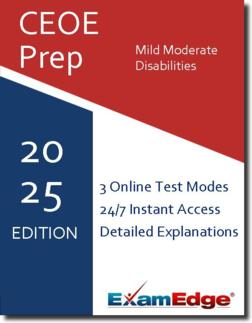CEOE Mild-Moderate Disabilities (29) Practice Tests & Test Prep by Exam Edge - Topics
Based on 29 Reviews
- Real Exam Simulation: Timed questions and matching content build comfort for your CEOE Mild-Moderate Disabilities test day.
- Instant, 24/7 Access: Web-based CEOE Mild-Moderate Disabilities practice exams with no software needed.
- Clear Explanations: Step-by-step answers and explanations for your CEOE exam to strengthen understanding.
- Boosted Confidence: Reduces anxiety and improves test-taking skills to ace your CEOE Mild-Moderate Disabilities (129).

Understanding the exact breakdown of the CEOE Mild-Moderate Disabilities test will help you know what to expect and how to most effectively prepare. The CEOE Mild-Moderate Disabilities has 80 multiple-choice questions and 1 essay questions. The exam will be broken down into the sections below:
| CEOE Mild-Moderate Disabilities Exam Blueprint | ||
|---|---|---|
| Domain Name | % | Number of Questions |
| Understanding Students with Mild/Moderate Disabilities | 12% | 10 |
| Assessing Students and Developing Individualized Education Programs (IEPs) and Individualized Family Service Plans (IFSPs) |
12% | 10 |
| Promoting Student Development and Learning | 45% | 36 |
| Working in a Collaborative Learning Community | 16% | 13 |
| Analysis of Data to Identify and Effectively Address Student Needs | 15% | 12 |


